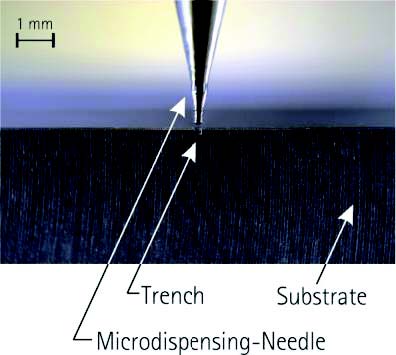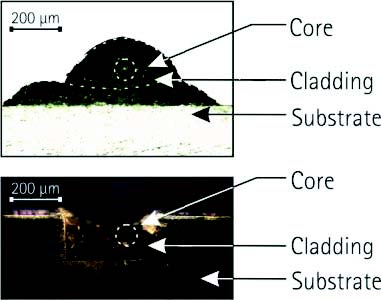Surface inherent energy and data transmission by optical signal coupling
In the subproject K1, micro-fibers have to be integrated into the component surface zone. The fibers serve for a surface inherent optical communication. This data communication is resistant to electromagnetic interference
and offers a high bandwidth. Furthermore, the sensory properties of the integrated fibers can be used for locally resolved measurement of physical changes, such as temperature differences and strains.
The fibers are directly bonded onto the surface, or integrated into a trench (Figure 1). The core of the fiber is produced using a combination of an extrusion and a drawing processes. Hereby, the core diameter can be varied between 10 and 50 microns. To realize the bonding to the surface, a UV-curing adhesive is used. Apart from the inherent bonding to the substrate surface, the adhesive polymer serves also as a cladding material. Consequently a total reflection at the boundary surface takes place between the fiber’s core and cladding, whereby the optical signal transmission is ensured.



For the application of the polymer, a micro-dispensing method is used (Figure 2). First, the initial cladding layer is dispensed. Thereafter, the fiber core is placed above. Subsequently, the upper cladding layer is dispensed
and cured with UV-radiation.



For the completion of the communication path, the optical waveguide must be coupled with an optical transmitter or receiver. For this purpose, the end facets are prepared with a micro abrasive procedure.
The realized surface inherent optical fibers are integrated into the sensory axis-slide of subproject N1. This enables communication with microsensors of subproject S1, which are also integrated onto the slide surface.
For an automated integration of the optical fiber onto the component surface, a gantry robot system is tested. In this system, the necessary steps, such as positioning, microdispensing, curing and end-facet preparation, should be performed.
The design of the system requires the consideration of the error and tolerance ranges of the processes used. In addition, the necessary positioning accuracy for an efficient signal coupling have to be determined. For this purpose, optical simulations and design of experiments are applied.
With the automated system, it will be possible to produce functional and surface-integrated optical waveguides in a single machine.



Subproject leader






